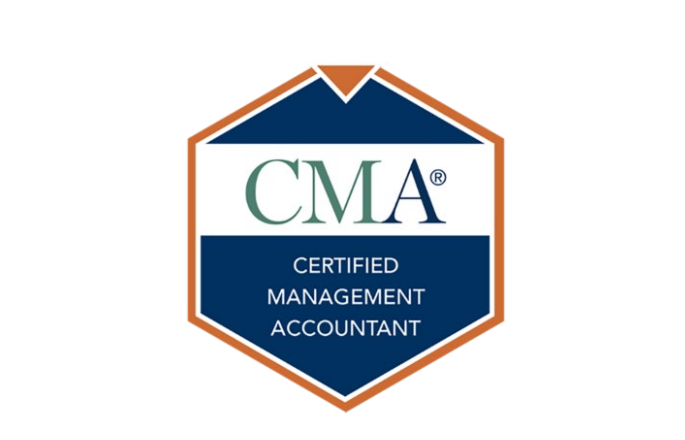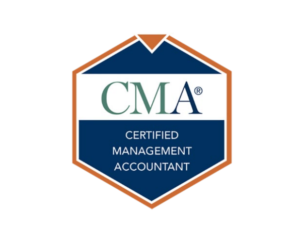- Description
- Curriculum
The Certified Management Accountant (CMA) exam is a professional certification credential designed to assess the skills and knowledge of management accounting and financial management professionals. The CMA designation is issued by the Institute of Management Accountants (IMA), and it is recognized globally as a standard of excellence in the field of management accounting.
The CMA exam is divided into two parts:
-
Part 1: Financial Planning, Performance, and Analytics
- This section focuses on planning, budgeting, and forecasting; performance management; cost management; internal controls; and technology and analytics. It evaluates the candidate’s ability to understand and apply concepts related to financial reporting, strategic planning, and analysis to improve business performance.
-
Part 2: Strategic Financial Management
- This section covers financial statement analysis, corporate finance, decision analysis, risk management, investment decisions, and professional ethics. It assesses the candidate’s ability to manage financial risks, make investment decisions, and ensure ethical financial practices within an organization.
Each part of the CMA exam consists of 100 multiple-choice questions and two essay questions. The multiple-choice questions test the candidate’s knowledge and application of various accounting and finance principles, while the essay questions assess the ability to apply this knowledge in real-world scenarios. Candidates are given four hours to complete each part of the exam.
To be eligible for the CMA certification, candidates must meet specific educational and professional experience requirements. Typically, a bachelor’s degree from an accredited college or university and two years of relevant work experience are required. Additionally, candidates must maintain membership in the IMA and adhere to its Statement of Ethical Professional Practice.
The CMA exam is known for its rigorous standards and comprehensive coverage of management accounting and financial management topics. Earning the CMA designation demonstrates a high level of expertise and commitment to the profession, enhancing career opportunities and credibility in the field of management accounting.
-
7A.1 Understanding the financial statements12:21
In this video, I provide an overview of financial accounting, focusing on the importance of financial statements and the different types of users who rely on them. I explain the concept of going concern assumption and the relevance, faithfulness, and comparability of financial information. I also touch on the relationship between different financial statements and the difference between accrual basis and cash basis accounting.
-
8A.2 The Balance Sheet15:54
In this video, I explain the fundamentals of the balance sheet, including the income statement, capital structure, and the basic accounting equation. I also discuss the different elements of the balance sheet, such as assets, liabilities, and equity. Throughout the video, I provide examples and explanations to help you understand how to interpret and analyze a balance sheet.
-
9A.3 Income Statement and Comprehensive Income18:25
In this video, I explain the purpose and structure of the income statement. I discuss the difference between the income statement and the balance sheet, and highlight the key elements of the income statement such as revenues, expenses, gains, and losses. I also explain the concept of discontinued operations and how they are reported in the income statement. By the end of the video, viewers will have a clear understanding of how the income statement reports the financial performance of a company over a period of time.
-
10A.4 Statement of Changes in Equity39:50
In this video, I explain the concept of equity and how it relates to balance sheets. I discuss the difference between income statements and balance sheet accounts, as well as the structure of the statement of changes in equity. I also cover topics such as preferred shareholders, treasury stock, and equity transactions. By the end of the video, you will have a clear understanding of how equity is calculated and reported in financial statements.
-
11A.5 Statement of Cash-Flows17:25
In this video, I explain the purpose of the statement of cash flows, which is to provide information about an entity's cash receipts and payments during a specific period. I discuss the concept of cash equivalents and how they are treated as cash. I also cover the three main activities in the statement of cash flows: operating, investing, and financing. Throughout the video, I highlight important examples and limitations of the cash flows statement.
-
12A.6 Accounts Receivable26:53
In this video, I explain the concept of accounts receivable, focusing on trade receivables, credit sales, and the allowance for credit losses. I detail the importance of monitoring uncollectible receivables, deducting discounts, and reporting accounts receivable accurately. Viewers will learn about cash discounts, accounting methods, and the reconciliation process for accounts receivable.
-
13A.7 Inventory Fundamentals1:04:56
In this video, I cover crucial aspects of inventory management, including definitions, valuation methods, and cost flow techniques. Pay close attention to topics like goods in transit, consigned goods, and inventory cost flow methods. Understanding FIFO and LIFO, as well as the impact of inventory discrepancies on financial statements, is key.
-
14A.8 Investments Types38:46
In this video, I explain the key concepts of investment accounting, focusing on debt and equity securities. I cover the six pillars of investment accounting, types of equity securities, and methods for accounting for investments. I also discuss the importance of creditor relationships and the classification of securities.
-
15A.9 PPE and Depreciation25:16
Dive into the world of accounting for property, plant, and equipment, and intangible assets with me. Learn about initial recognition, measurement, depreciation, and impairment assessments.
-
16A.10 Intangible Assets14:35
In this video, I delve into the world of intangible assets, covering their types, recognition, amortization, and impairment. Key points include the distinction between finite and indefinite useful life assets, the calculation of goodwill, and the accounting treatment for patents.
-
17A.11 Reclassifications of Short Term Debt6:55
Today's video covers the reclassification of short-term debt, focusing on conditions, criteria, and additional considerations for companies looking to reclassify short-term debt as long-term. I explain the importance of demonstrating both the intention and ability to refinance, along with key steps and implications for partial refinancing. Watch to grasp the nuances of this financial process.
-
18A.12 Warranties Assurance Type vs Service Type19:12
In this video, I explain the concept of warranties in accounting, focusing on assurance type and service type warranties. I cover the types of warranties, accounting treatment, recognition of expenses, and additional considerations for both types
-
19A.13 Leases9:38
In this video, I delve into the intricacies of lease classification and accounting, focusing on finance and operating leases. I explain the criteria for determining a finance lease, the recognition of assets and liabilities, amortization processes, and the calculation of lease payments. Viewers will gain a comprehensive understanding of how leases are classified and accounted for, essential for financial reporting and decision-making.
-
20A.14 Income Tax24:40
In this video, I explain the components of income tax expenses, including current and deferred tax expenses, temporary differences between GAAP and tax accounting, and the concept of deferred tax liabilities and assets. I also cover intraperiod versus interperiod tax allocation and provide examples of timing differences
-
21A.15 Revenue Recognition9:50
In this video, I explain the five-step model for recognizing revenue, focusing on accrual accounting principles. I discuss the importance of contracts, performance obligations, transaction prices, and revenue recognition criteria.
-
22A.16 Impairment and Disposal of Long Lived Assets21:08
In this video, I cover the essential concepts of impairment and disposal of long-lived assets, explaining the two-step process of the impairment test and the actions needed for recognition and accounting entries.
-
23A.17 Integrated Reporting28:16
In this video, I explain the concept of integrated reporting, which combines financial and non-financial information to provide a holistic view of an organization's value creation process. I discuss the evolution from traditional financial reporting to integrated reporting, highlighting key principles, benefits, and challenges. Viewers are encouraged to consider the long-term sustainability and value creation aspects emphasized in integrated reporting.
-
24A 18 Contingencies4:40
-
25B.1 Strategic Management and Planning43:38
-
26B.2 Correlation and Regression39:41
-
27B.3 Roles of Budgets and the Budgeting Process36:38
-
28B.4 Budgeting and Standard Costs16:06
-
29B.5 The Master Budget5:37
-
30B.6 Budget Methodologies in Project Management11:43
-
31B.7 Sales Forecasts and the Sales Budget4:56
-
32B.8 Operating Budget Calculations Production and Direct Materials13:44
-
33B.9 Operating Budget Calculations and Components21:25
-
34B.10 Capital Budgeting and Cash Management10:12
-
35B.11 Pro Forma Financial Statements7:22
-
36C.1 Cost Accounting Concepts and Methods28:45
-
37C.2 Cost Accumulation Systems in Accounting6:24
-
38C.3 Inventory Costing Methods Absorption vs Variable Costing40:41
-
39C.4 Job Order Costing Accumulating and Applying Costs11:40
-
40C.5 Process Costing A Comprehensive Guide2:40
-
41C.6 Activity Based Costing ABC26:08
-
42C.7 Life Cycle Costing A Comprehensive Approach to Product Management8:47
-
43C.8 Physical Measure Based Approach for Joint Production Costs5:40
-
44C.9 Market-Based Approaches for Joint-Cost Allocation20:40
-
45C.10 Overhead Allocation and Normal Costing34:46
-
46C.11 Just in Time Inventory and Lean Resource Management18:33
-
47C.12 Enterprise Resource Planning and Outsourcing28:11
-
48C.13 Value Chain Analysis and Supply Chain Management16:01
-
49C.14 Process Improvement Tools and Techniques38:26
-
50D.1 Variance Analysis Overview24:57
-
51D.2 Static and Flexible Budget Variances18:39
-
52D.3 Direct Materials Variances22:30
-
53D.4 Direct Labor Variances11:01
-
54D.5 Mix and Yield Variances Overview11:28
-
55D.6 Overhead Variances Overview20:35
-
56D.7 Sales Variances OverviewVideo lesson
-
57D.8 Responsibility Centers15;34
-
58D.9 Performance Measures Cost Revenue and Profit Centers8:56
-
59D.10 Performance Measures for Investment Centers21:25
-
60D.11 The Balanced Scorecard and Key Performance IndicatorsVideo lesson
-
61D.12 Transfer Pricing Methods and ConsiderationsVideo lesson
-
62E.1 Corporate Governance and Internal Control Regulations44:06
-
63E.2 Risk and Internal Control A Comprehensive Overview31:10
-
64E.3 Control Procedures and Types of Controls in Organizations42:28
-
65E.4 Systems Controls and Information SecurityVideo lesson
-
66E.5 Security Measures and Business Continuity Planning20:56
-
72A.1 Understanding the financial statements6:35
-
73A.1 Video Explanation6:36
-
74A.2 The Balance Sheet10:58
-
75A.2 Video Explanation10:59
-
76A.3 Income Statement and Comprehensive Income11:48
-
77A.3 Video Explanaion11:49
-
78A.4 Statement of Changes in Equity16:25
-
79A.4 Video Explanation16:26
-
80A.5 Statement of Cash-Flows12:38
-
81A.5 Video Explanation12:39
-
82A.6 Accounts Receivable14:05
-
83A.6 Video Explanation14:06
-
84A.7 Inventory Fundamentals38:49
-
85A.7 Video Explanation38:51
-
86A.8 Investments Types26:26
-
87A.8 Video Explanation26:27
-
88A.9 PPE and Depreciation17:54
-
89A.9 Video Explanation17:55
-
90A.10 Intangible Assets15:18
-
91A.10 Video Explanation15:19
-
92A.11 Reclassifications of Short Term Debt8:05
-
93A.11 Video Explanation8:07
-
94A.12 Warranties Assurance Type vs Service Type7:02
-
95A.12 Video Explanation7:04
-
96A.13 LeasesText lesson
-
97A.14 Income Tax16:42
-
98A.14 Video Explanation16:43
-
99A.15 Revenue Recognition31:43
-
100A.15 Video Explanation34:45
-
101A.16 Impairment and Disposal of Long Lived Assets13:14
-
102A.16 Video Explanation13:15
-
103A.17 Integrated Reporting28:15
-
104A.17 Video Explanation28:16
-
105B.1 Strategic Management and Planning10:34
-
106B.2 Correlation and RegressionText lesson
-
107B.3 Roles of Budgets and the Budgeting Process10:56
-
108B.4 Budgeting and Standard Costs8:03
-
109B.5 The Master Budget6:54
-
110B.6 Budget Methodologies in Project Management4:55
-
111B7. Sales Forecasts and Pro Forma Financial StatementsText lesson
-
112B8. Operating Budget Calculations - Production and Direct MaterialsText lesson
-
113B9. Operating Budget Calculations - OthersText lesson
-
114B.10 Capital Budgeting and Cash ManagementText lesson
-
115Expected ValueText lesson
-
116The Balanced ScorecardText lesson
-
117D.1 Variance Analysis OverviewText lesson
-
118D.2 Static and Flexible Budget VariancesText lesson
-
119D.3 Direct Materials VariancesText lesson
-
120D.4 Direct Labor VariancesText lesson
-
121D.5 Mix and Yield Variances OverviewText lesson
-
122D.6 Overhead Variances OverviewText lesson
-
123D.7 Sales Variances OverviewText lesson
-
124D.8 Responsibility CentersText lesson
-
125D.9 Performance Measures Cost Revenue and Profit CentersText lesson
-
126D.10 Performance Measures for Investment CentersText lesson
-
127D.11 The Balanced Scorecard and Key Performance IndicatorsText lesson
-
128D.12 Transfer Pricing Methods and ConsiderationsText lesson
-
129C.1 Cost Accounting Concepts and Methods53:28
-
130C.2 Cost Accumulation Systems in Accounting4:05
-
131C.3 Inventory Costing Methods Absorption vs Variable Costing7:33
-
132C.4 Job Order Costing Accumulating and Applying CostsText lesson
-
133C.5 Process Costing A Comprehensive GuideText lesson
-
134C.6 Activity Based Costing ABCText lesson
-
135C.7 Life Cycle Costing A Comprehensive Approach to Product Management5:34
-
136C9. & C.8 Joint Product and By-Product CostingText lesson
-
137C.10 Overhead Allocation and Normal CostingText lesson
-
138C.11 Just in Time Inventory and Lean Resource Management7:04
-
139C.12 Enterprise Resource Planning and OutsourcingText lesson
-
140C.13 Value Chain Analysis and Supply Chain ManagementText lesson
-
141C.14 Process Improvement Tools and TechniquesText lesson
-
142Absorption and Variable Costing – CalculationsText lesson
-
143Overhead Allocation and Normal Costing -- CalculationsText lesson
-
144Allocating Service Department Costs – TheoryText lesson
-
145Allocating Service Department Costs – CalculationsText lesson
-
153External Financial Reporting DecisionsText lesson
-
154Planning, Budgeting and ForecastingText lesson
-
155Cost ManagementText lesson
-
156Performance ManagementText lesson
-
157Review 1-5Text lesson
-
158Review 1-10Text lesson
-
159Section A Final ReviewText lesson
-
160Chapter 1 FinalText lesson


